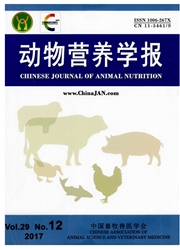

 中文摘要:
中文摘要:
本试验旨在筛选廉价的碳水化合物原料用于配制断奶仔猪日粮。选用60头体重为(8.0±0.1)kg的三元杂交断奶仔公猪,随机分为5个处理,每处理3个重复,每个重复4头猪。试验以玉米-豆粕型基础日粮作为对照组;4个试验组分别用6%的葡萄糖、蔗糖、乳糖和玉米淀粉取代基础日粮中的等量玉米。试验期28 d。试验结束时,采集试猪肠道内容物,通过平板计数法和PCR/DGGE技术,观察不同碳水化合物对断奶仔公猪肠道微生物的影响。结果表明,回肠和结肠乳酸菌数量乳糖组显著高于其他各组(P〈0.05),盲肠乳酸菌数量也有高于其他各组的趋势(P〉0.05);回肠和盲肠肠杆菌数量依次为玉米淀粉组〉对照组〉蔗糖组〉葡萄糖组〉乳糖组(P〉0.05),结肠肠杆菌数量依次为蔗糖组〉玉米淀粉组〉对照组〉乳糖组〉葡萄糖组(P〉0.05)。在DGGE图谱上,仔猪回肠和盲肠内容物微生物种类较少,而结肠内容物微生物数量较多;各处理组间及不同肠段间DGGE图谱相似性在50%-75%之间,表明日粮不同碳水化合物来源对DGGE图谱的影响不太明显。综合以上结果,断奶仔猪日粮中添加6%的乳糖能改善断奶肠道微生物区系,玉米淀粉对断奶仔猪的肠道微生物的作用较差,不宜单独添加于断奶仔猪日粮中。
 英文摘要:
英文摘要:
This study was conducted to select cheaper carbohydrate sources used in the diets of weaned piglets. Sixty Duroc × Landrace× Yordshire piglets (male,average BW (8.0 ± 0.1)kg) weaned on day 28 were randomly assigned to 5 treatments, which were replicated 3 times with 4 piglets each. Corn-soybean meal based diet was used in the control (CR) group, while glucose (GLU) ,sucrose (SUC) ,lactose (LAC) and cornstarch (CS) were used at 6 percent of the total diets in the other four groups to substitute for equal corn, respectively. The experiment lasted twenty-eight days. At the end of the experiment, intestinal contents were collected to determine the microbes by Plate Count method and PCR-DGGE technique. The results showed that the numbers of Lactobacillus in LAC group were higher (P〈0.05) than other 4 groups in ileum and colon,and were also higher (P〉0.05) than other 4 groups in cecum. For all treatments, the numbers of Enterobacteria in ileum and cecum were CS〉CR〉SUC〉GLU〉LAC (P〉0. 05) ,the numbers of Enterobacteria in colon SUC〉CS〉CR〉LAC〉GLU (P〉0.05). In DGGE map,the microbial communities were relative lack in jejunum and cecum,while the microbial communities were rich in the colon. The similarities between DGGE profiles of all treatments or all regions of the intestine (50% -75% ) indicated that the different carbohydrate sources diets showed no apparent effect on the DGGE profiles. According to the results, adding 6% lactose to the diet for weaned piglet could optimize the intestinal microbial communities while cornstarch not be used singly in the diet because of its unconspicuous effect on the intestinal microbial communities.
 同期刊论文项目
同期刊论文项目
 同项目期刊论文
同项目期刊论文
 Dietary supplementation with Chinese herbal ultra-fine 3 powder enhances cellular and humorl immunit
Dietary supplementation with Chinese herbal ultra-fine 3 powder enhances cellular and humorl immunit Comparison of the regression analysis technique and the substitution method for the determination of
Comparison of the regression analysis technique and the substitution method for the determination of Dietary supplementation with polysaccharides from Semen cassiae enhances immunoglobulin production a
Dietary supplementation with polysaccharides from Semen cassiae enhances immunoglobulin production a Chinese herbal ingredients are effective immune stimulators for chickens infected with the Newcastle
Chinese herbal ingredients are effective immune stimulators for chickens infected with the Newcastle Dietary supplementation with acanthopanax senticosus extract modulates gut microflora in weaned pigl
Dietary supplementation with acanthopanax senticosus extract modulates gut microflora in weaned pigl Dietary L-arginine supplementation increases muscle gain and reduces body fat mass in growing-finish
Dietary L-arginine supplementation increases muscle gain and reduces body fat mass in growing-finish Intramuscular administration of zinc metallothionein to preslaughter stressed pigs improves anti-oxi
Intramuscular administration of zinc metallothionein to preslaughter stressed pigs improves anti-oxi Effects of Chinese herbal ultra-fine powder as a dietary additive on growth performance, serum metab
Effects of Chinese herbal ultra-fine powder as a dietary additive on growth performance, serum metab Effect of galacto-mannan-oligosaccharides or chitosan supplementation on cytoimmunity and humoral im
Effect of galacto-mannan-oligosaccharides or chitosan supplementation on cytoimmunity and humoral im Effect of replacement of lactose with partially hydrolysed rice syrup on small intestine development
Effect of replacement of lactose with partially hydrolysed rice syrup on small intestine development Rice protein concentrate partially replaces dried whey in the diet for early-weaned piglets and impr
Rice protein concentrate partially replaces dried whey in the diet for early-weaned piglets and impr Dietary Arginine Supplementation Increases mTOR Signaling Activity in Skeletal Muscle of Neonatal Pi
Dietary Arginine Supplementation Increases mTOR Signaling Activity in Skeletal Muscle of Neonatal Pi 期刊信息
期刊信息
